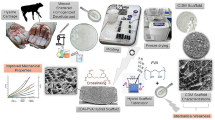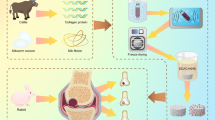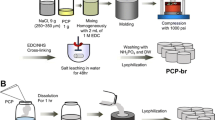Abstract
Hybrid scaffolds composed of hyaluronic acid (HA) and collagen was prepared and evaluated for cartilage regeneration. The hybrid scaffolds prepared by adding 0.1, 0.3 or 0.5 wt.% collagen to HA had a three-dimensional structure with interconnected pores and showed an increase in tensile strength with increasing collagen concentration. The degradation period of the hybrid scaffolds in vitro increased with increasing collagen concentration and that the cell growth in the hybrid scaffolds increased with increasing collagen concentration for 2 weeks of cell culture. After the hybrid scaffolds with different collagen concentrations were implanted into cartilage defects of rabbit ears for 6 months, the GAG concentration of the hybrid scaffolds was higher than the HA scaffold itself, suggesting that cartilage tissue was easily formed in the collagen-containing scaffolds although the GAG concentration in the hybrid scaffolds decreased with increasing collagen concentration. Therefore, it is concluded that the collagen- containing porous scaffolds can be effectively used for cartilage regeneration.
Similar content being viewed by others
References
FT Blevins, JR Steadman, JJ Rodrigo, Treatment of articular cartilage defects in athletes: an analysis of functional outcome and lesion appearance, Orthopedics, 21, 761 (1998).
DD Frisbie, GW Trotter, BE Powers, Arthroscopic subchondral bone plate microfracture technique augments healing of large chondral defects in the radial carpal bone and medial femoral condyle of horses, Vet Surg, 28, 242 (1999).
M Geiger, RH Li, W Friess, Collagne sponges for bone regeneration with rhBMP-2, Adv Drug Deliv Rev, 55, 1613 (2003).
SE Sakiyama, JA Hubbel, Development of fibrin derivatives for controlled release of heparin-binding growth factors, J Control Release, 65, 389 (2000).
HD Kim, RF Valentini, Retention and activity of BMP-2 in hyaluronic acid-based scaffolds in vitro, J Biomed Mater Res, 59, 573 (2002).
N Saito, T Okada, H Horiuchi, et al., Local bone formation by injection of recombinant human bone morphogenetic protein-2 contained in polymer carriers, Bone, 32, 381(2003).
V Ladeda, JA Aguirre Ghiso, E Bal de Kier Joffé, Function and expression of CD44 during spreading, migration, and invasion of murine carcinoma cells, Exp Cell Res, 242, 515 (1998).
K Hemmrich, D vonHeimburg, R Rendchen, et al., Implantation of preadipocyte-loaded hyaluronic acid-based scaffolds into nude mice to evaluate potential for soft tissue engineering, Biomaterials, 26, 7025 (2005).
FL Nicolas, CH Gagnieu, Denatured thiolated collagen II. crosslinking by oxidation, Biomaterials, 18, 815(1997).
G Goissis, EJ Marcantonio, RA Marcantonio, et al., Biocompati bility studies of anionic collagen membranes with different degree of glutaraldehyde cross-linking, Biomaterials, 20, 27(1999).
Q Lu, K Ganesan, DT Simionescu, et al., Novel porous aortic elastin and collagen scaffolds for tissue engineering, Biomaterials, 25, 5227 (2004).
S Zhang, MC Chang, D Zylka, et al., The hyaluronan receptor RMAMM regulates extracellular-regulated kinase, J Biol Chem, 273, 1342 (1998).
JJ Kim, YD Park, GY Tae, et al., Characterization of low molecular-weight hyaluronic acid-based hydrogel and defferential stem cell responses in the hydrogel microenvironments, J Biomed Mater Res, 88, 967 (2009).
YI Chung, SY Lee, SH Yuk, A facile method to prepare heparin-functionalized nanoparticles for controlled release of growth factors, Biomaterials, 27, 2621 (2006).
L Calderon, E Collin, D Velasco-Bayon, et al., Type II collagenhyaluronan hydrogel—a step towards a scaffold for intervertebral disc tissue engineering, Eur Cell Mater, 20, 134 (2010).
LE Freed, G Vunjak-Novakovic, RJ Biron, et al., Biodegradable polymer scaffolds for tissue engineering, Biotechnology, 7, 689 (1994).
LT Jensen, NB Host, Collagen: scaffold for repair or execution, Cardiovasc Res, 3, 535 (1997).
T Fujisato, T Sajiki, Q Liu, et al., Effect of basic fibroblast growth factor on cartilage regeneration in chondrocyte-seeded collagen sponge scaffold, Biomaterials, 2, 155 (1996).
B Hafemann, S Ensslen, C Erdmann, et al., Use of a collagen/ elastin-membrane for the tissue engineering of dermis, Burns, 5, 373 (1999).
CH Lee, A Singla, Y Lee, Biomedical applications of collagen, Int, J Pharm, 221, 1 (2001).
RM Mason, MV Crossman, C Sweeney, Serotonin immuno cytochemistry of physiologically characterized raphe magnus neurons, in: T.C. Laurent (Ed.), The Biology of Hyaluronan, New York, 1989, pp. 107–121.
Author information
Authors and Affiliations
Corresponding author
Rights and permissions
About this article
Cite this article
Kim, H.J., Kim, K.K., Park, I.K. et al. Hybrid scaffolds composed of hyaluronic acid and collagen for cartilage regeneration. Tissue Eng Regen Med 9, 57–62 (2012). https://doi.org/10.1007/s13770-012-0007-7
Received:
Revised:
Accepted:
Published:
Issue Date:
DOI: https://doi.org/10.1007/s13770-012-0007-7




